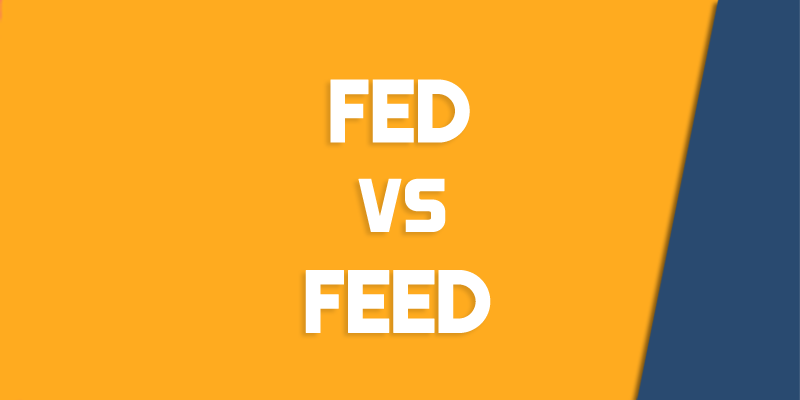Feed vs. Fed – What’s the Gist?
There is little difference between these two verbs except in relationship to time.
- Feed is a transitive verb.
- Fed is a transitive verb.
The three principal parts of the verb are the present—feed, the past—fed, and the past participle—(have) fed. Feed functions as an intransitive verb and a noun as well.

How to Use Feed in a Sentence
Feed definition: As mentioned, the word feed has several nuances in denotation. Besides being a transitive verb (passing action to a subject or a direct object), it also acts an intransitive verb (expressing action), or it functions as a noun.
As a transitive verb, it means to give food to or give as food; to furnish something that’s fundamental to development or growth; to supply (something) to a machine; or to deposit (something) repeatedly.
For example:
- The livestock rancher feeds his cattle hay. (Present Tense Verb)
- The parents took their children to the art museum regularly to feed their souls with the beautiful things. (Infinitive)
- The teller feeds lose change into the change counting machines nearly every single day. (Present Tense Verb)
As an intransitive verb, feed means to consume food; to become nourished by food; to become directed; to move into a machine in order to be processed. Remember, an intransitive verb expresses action, but there is no direct object either to receive or to pass the action.
For example:
- The lion feeds on the prey. (Present Tense Verb)
- The lions feed until satiated. (Present Tense Verb)
- The paper feeds into the printer to make copies. (Present Tense Verb)
Furthermore, the term feed is a noun, meaning an act of eating; food for livestock; a process of a signal transmission to a broadcasting station; or an internet service which updates electronic information as a continuous stream.
For example:
- The goat receives its feed twice a day. (Noun)
- The local broadcasting station receives several audio and video feeds for transmission. (Noun)
- To stay informed, every day the woman checks her news feed on social media. (Noun)
The word feed is a versatile one, functioning as a transitive and intransitive verb and as a noun.
How to Use Fed in a Sentence
Fed definition: To put it simply, the word fed functions as the second and third principal parts of the verb feed. These two principal parts are used to form the past tense (fed) and all three perfect tenses (has fed, had fed, will have fed).
For example:
- The boy fed the dogs yesterday. (Past Tense Verb)
- The boy has fed the dogs already. (Present Perfect Tense Verb)
- The boy had fed the dog before he departed for school. (Past Perfect Tense Verb)
- By the end of the day, the boy will have fed the dog. (Future Perfect Tense Verb)
The word fed is more likely to be used as a past tense verb, but it does have some other verb functions to be aware of as well.
By the way, the past perfect and the future perfect tenses are used to clarify two different actions occurring in a sentence.
Outside Examples of Feed vs. Fed
- They learn about the calves’ growth and how to feed them, groom them and keep record books. At the state fair, they compete with others in their age bracket across the state. –Tampa Bay Times
- “As insects are cold-blooded, they require less energy to stay warm. This helps explain why they are more efficient at converting feed into protein,” Vazquez Landeta said. “Consider that crickets need four times less feed than sheep, 12 times less than cattle, and half as much as broiler chickens and pigs to produce the same amount of protein.” –New York Post
- While George rides off, hopefully in his car with Wendy safely at the wheel, I remain here, committed to local journalism in the region that raised, fed and allowed me into its dusty corners to share its stories. –The Plain Dealer
- That’s why the best pest control is keeping your plants well-fed and hydrated, she said, with deep watering that pushes their roots deep into cooler ground, a soil that is rich with nutrients and organic matter and a thick mulch that help keep the soil moist. –LA Times
Phrases That Use Feed and Fed
There are several idioms that use the word feed or fed, including:
Don’t bite the hand that feeds you: An admonition to be more grateful toward the person who is providing something.
- When the girl expressed dismay at cell phone brand that was given to her as a present, her mother said, “Don’t bite the hand that feeds you.”
Feed a cold and starve a fever: An old wives’ tale suggesting that one should take nourishment during a minor illness but withhold food during a major infection.
- Grandma brought the family her famous chicken noodle, saying as she served it, “Feed a cold and starve a fever.”
To be spoon-fed: To give help to such an extent that a person is doing little to help herself.
- The parent spoon-fed his child by doing the science fair project for her.
Fed up: To be angry or frustrated by someone.
- The teacher was fed up with students’ parents doing the projects for their children.
How to Remember These Words
The bottom line for remembering these two words is to know whether you need the present (feed) or past tense (fed) verb.
A mnemonic device that may help you is to keep these two words straight is to remember that there are two e’s in the word feed and in the word present. So, if you want the present form of the verb, pick feed.
Article Summary
Is feed or fed correct? These are essentially the same terms. Do you need a present tense verb? If so, choose feed. Do you need past tense or a past participle? Then use fed.
- Feed acts as a verb and a noun.
- Fed is the past tense verb of feed.
